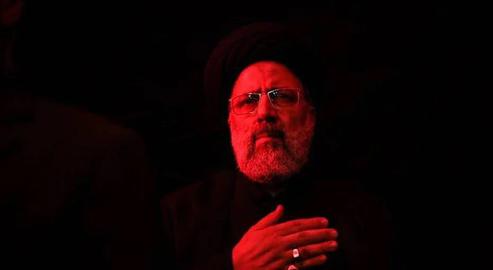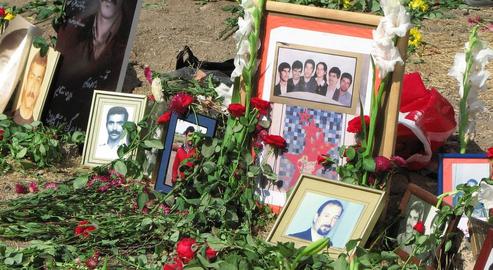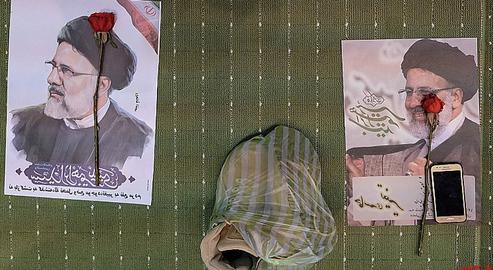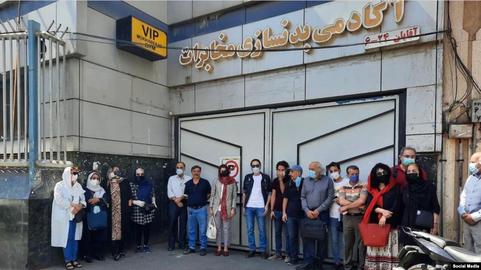The years 1988 to 1994 witnessed the stratospheric rise of Ebrahim Raisi from middling to senior member of the Iranian judiciary. His membership on Ayatollah Khomenei’s death panel, which sent thousands of political prisoner to their deaths in 1988, effectively turbo-charged the now-presidential frontrunner’s career. It appears, however, that Raisi himself is conflicted about his decisive role in the massacre.
The biography on Raisi’s personal website – and on other government websites – state that the first Supreme Leader of the Islamic Republic put him in charge of “several important cases”. But the specifics of what this entailed are not mentioned.
Meanwhile, Raisi has denied having had a direct role in the mass murder of Iranian citizens, claiming “I had none of the three positions specified” by Khomeini as being decision-making roles. He has also sought to downplay his role on the death panel by expounding on the differences between “a judge and a prosecutor”.
Raisi has also claimed that the panel’s only task was to decide how the death sentences were to be carried out, even though both Ayatollah Montazeri, once the designated successor to Ayatollah Khomeini, and other members of the panel have clearly stated that panel was responsible for issuing the death sentences themselves. All those killed were already serving jail sentences issued by the Revolutionary Court.
During the campaign for the 2017 presidential election, when Raisi stood as a candidate, Hassan Rouhani and his supporters emphasized his role in the 1988 massacre and some even gave him nicknames such as “Ayatollah Massacre”.
The dark cloud of 1988 hangs heavily enough on Raisi that it has overshadowed his role in other important cases that same year. Correspondence by Ayatollah Khomeini dated in the second half of 1988 indicates Raisi received at least three “special assignments to directly handle judicial problems” in a number of provinces, and was asked to act “independently” of the court system.
These “important cases” related to the three provinces of Lorestan, Semnan and Kermanshah. In July 1988, about 7,000 fighters from the opposition People’s Mojahedin Organization (MEK), supported by the Iraqi Air Force, entered Kermanshah province in western Iran.
In response, Iran launched Operation Mersad: a massive military maneuver that crushed the MEK within days. Given the timing of Raisi’s assignment to act “independently” of the judicial system, it can probably be surmised that he was tasked with dealing with the disruptors.
In one of his letters, Khomeini told Raisi and Hossein Ali Nayeri, another former member of the death panel, to take “serious action” in the cities of Semnan, Sirjan, Eslam Abad and Dorud, without paying attention to “bureaucratic twists and turns”.
In yet another letter, dated January 13, 1989, Khomeini asked Nayeri and Raisi to act according to their own judgement and remove any obstacles in the path of “issuing divine verdicts” because, he said, high judiciary officials showed no sensitivity whatsoever towards “shocking” issues. The letter does not spell out the substance of the “issues” they were to handle, but it is safe to assume Khomeini wanted them to bypass the judicial system.
Eight days after this missive, Ayatollah Khomeini gave Nayeri and Raisi yet another important assignment. On January 21, 1989, he ordered the Supreme Judiciary Council to “turn over to Messrs. Nayeri and Raisi all cases that, as of now, the council has surprisingly neglected, delaying the execution of divine verdicts so that God’s judgments can be carried out as soon as possible. Delay is not acceptable.”
A Rise to High-level Positions in the 1990s
Ayatollah Khomeini died in June 1989, not long after issuing these orders. His successor was Ali Khamenei, Raisi’s fellow right-winger. After changes to the constitution, Mohammad Yazdi, a conservative clergymen, was appointed as head of the judiciary and Raisi was promoted to the job of Tehran Revolutionary Prosecutor, a post he went on to hold for five years.
The laws passed after Khomeini’s death gave the Revolutionary Prosecutor broad powers to prosecute government officials, including cases of “domestic conspiracies” against the Islamic Republic, which were then used to eliminate rival forces in the political field.
Then 1992, Mashhad became the scene of the first big riot after Khomeini’s death. Unrest erupted in a neighborhood housing seminary students over the demolition of houses that had been built without the necessary permits, and quickly spread to other parts of the city. Once the protests had been suppressed, Raisi was sent to Mashhad as a special representative of the judiciary to put the detained protesters on trial – once again outside of the normal legal processes. He sentenced a number of them to death.
In 1994, Mohammad Yazdi appointed Raisi as the head of Iran’s General Inspection Office, a body with powers to investigate government institutions to prevent and fight corruption. Raisi’s tenure at the head of this agency lasted for 10 years.
His assumption of the role coincided with the end of Akbar Hashemi Rafsanjani’s last term as president, when, Iran’s principalists claim, extensive corruption in the Islamic Republic was beginning to take root. Most of the corruption cases involved the relatives and associates of government officials, including the famous case of large-scale embezzlement at Bank Saderat. In this case Morteza Rafighdoost, a former head of Khomeini’s security detail in 1979 and brother of Mohsen Rafighdoost, the president of massive parastatal conglomerate the Mostazafan Foundation, was ultimately jailed for 10 years.
Despite the scale of financial crime being unearthed at that time, there are no reports of what role, if any, the General Inspection Office played in these high-profile cases. In an official report issued by the Iranian parliament, the Office is credited with having brought charges against a perpetrator in just one case.
However, under Raisi, the General Inspection Office was very active in pursuing cases against the Islamic Republic’s so-called “left-wing”, including the Petropars affair, when reformist politician Behzad Nabavi, the company chairman, was indicted. Petropars was registered in early 1998 by order of the Supreme Economic Council so the development of the first phase of the South Pars natural-gas condensate field, the biggest of its kind in the world, could get started with an Iranian private contractor. In the end, the charges in this case encompassed Petropars’ entire board of directors, forcing Behzad Nabavi and economist Masoud Karbasian to resign in the early 2002.
One of most controversial cases Raisi sent to court during his tenure as the head of General Inspection Office was that of Gholam Hossein Karbaschi, the reformist mayor of Tehran. In 1998, Karbaschi was convicted of corruption and misuse of funds and jailed.
President Khatami’s administration always held that the case against him was intended to put pressure on the government. It might even have been a calculated act of revenge against Karbaschi, who had played an important role in the principalists’ defeat in the 1997 presidential election.
Flip-Flopping on Privatization and Religious Honorifics
Raisi’s tenure at the General Inspection Office also coincided with the outset of extensive privatization in Iran, which he later spoke against only after it became clear that the process had led to widespread corruption. Of course, the privatization of any large state-owned firm would have needed the approval of his agency, but he made no mention of this at the time.
Latently, though, it appears that Raisi has changed his position again. On Thursday, May 27, he held his first news conference as an official 2021 presidential candidate at Tehran’s Chamber of Commerce. There, Raisi defended privatization and “the market”, criticizing what he termed the “command economy”. Privatization must continue, he said, even if certain “specific problems” needed resolving.
As Alex Vatanka of the Middle East Institute observes, Raisi’s religious qualifications have been a sore point during presidential campaigns: “For a while on his personal website, he referred to himself as an ‘Ayatollah’. When Iranian media investigated and publicized his lack of a formal religious education, Raisi balked. Today, he no longer claims to hold that rank and instead refers to himself as Hojjatoleslam: a clerical rank lower than ayatollah in status and privilege.”
In the early 1990s, Raisi tried to burnish his religious credentials by attending high-level seminary classes taught by Mahmoud Hashemi Shahroudi, Mojtaba Tehrani and Ali Khamenei himself. The irony was that, at the time, Khamenei was also new to his position as the Supreme Leader and was teaching these high-level courses in a bid to prove to doubters that he too was indeed an Ayatollah and a “source of emulation”.
Related coverage:
Ebrahim Raisi: The Bloodstained Early Years
Ebrahim Raisi: The Hanging Judge Set to Become Iran's Next President
Faezeh Hashemi: This is Not an Election, It’s an Appointment
Letter to the Wife of Iran’s Chief Justice: Your Husband Killed My Husband
Ali Larijani Knocked Out of Iran's Presidential Race as Candidates Announced
Ebrahim Raisi’s Presidential Candidacy: A Gamble on Succeeding Khamenei
IranWire Exclusive: Chief Justice Using Fabricated Supporters in Presidential Bid
visit the accountability section
In this section of Iran Wire, you can contact the officials and launch your campaign for various problems



























comments